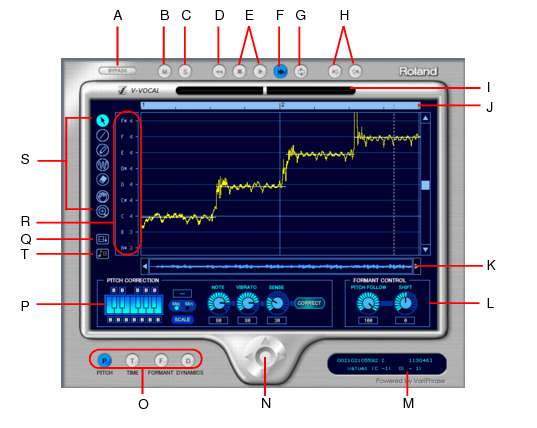The following topics describe using the V‑Vocal interface to process audio data. For information about inserting and managing V‑Vocal in Sonar, see V-Vocal Region FX clips.Figure 498. V‑Vocal.A. Bypass B. Mute C. Solo D. Rewind E. Play/Stop F. AutoScroll G. LoopMode H. Undo/Redo I. Cent indicator J. Timeline K. Scroll L. Formant control M. Information view N. Zoom O. Edit mode P. Pitch correction Q. Spread editing area R. Select pitch correction key S. Tools T. Pitch to MIDI












. For selecting the editing region, and for increasing or decreasing the pitch of the selected region.

. For drawing Pitch, Formant, and Dynamics with straight lines.

. For drawing Pitch, Formant, and Dynamics freehand.

. For adding and editing Vibrato or LFO at the selected region.

. For resetting the selected region to its initial value.

. For scrolling the display. If you drag in the editing area while pressing the CTRL key, you can zoom.

. For selecting an area to zoom in to. Drag a border around the area you want to zoom to. Overall area is displayed by double clicking.
Tip - Searching Documentation
Tip: To search for a specific topic, type your search query in the Search Cakewalk.com field at the top right of this page.
When the search results appear, click which product's documentation you would like to search to filter the search results further.
Note - Using Offline Help
Note: If you prefer to always use offline Help, go to Edit > Preferences > File > Advanced in your Cakewalk software and select Always Use Offline Help.
If you are not connected to the internet, your Cakewalk software will default to showing offline help until an internet connection becomes available.




